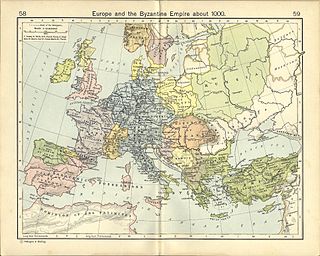
Back Latín medieval AN لاتينية العصور الوسطى Arabic Llatín medieval AST Llatí medieval Catalan Middelalderlatin Danish Mittellatein German Mezepoka latino Esperanto Latín medieval Spanish لاتین قرون وسطی Persian Latin médiéval French
This article needs additional citations for verification. (May 2013) |
| Medieval Latin | |
|---|---|
 Carmina Cantabrigiensia, Medieval Latin manuscript | |
| Native to | Numerous small states |
| Region | Mediaeval Latin/Western Christendom (Most of Europe) |
| Era | Developed from Late Latin between 4th and 10th centuries; replaced by Renaissance Latin from the 14th century |
Indo-European
| |
Early forms | |
| Latin alphabet | |
| Official status | |
Official language in | De facto in most Catholic and/or Romance-speaking states during the Middle Ages[a] |
| Language codes | |
| ISO 639-3 | – |
lat-med | |
| Glottolog | medi1250 |
 Europe, AD 1000 | |
Medieval Latin was the form of Literary Latin used in Roman Catholic Western Europe during the Middle Ages. In this region it served as the primary written language, though local languages were also written to varying degrees. Latin functioned as the main medium of scholarly exchange, as the liturgical language of the Church, and as the working language of science, literature, law, and administration.
Medieval Latin represented a continuation of Classical Latin and Late Latin, with enhancements for new concepts as well as for the increasing integration of Christianity. Despite some meaningful differences from Classical Latin, its writers did not regard it as a fundamentally different language. There is no real consensus on the exact boundary where Late Latin ends and Medieval Latin begins. Some scholarly surveys begin with the rise of early Ecclesiastical Latin in the middle of the 4th century, others around 500,[1] and still others with the replacement of written Late Latin by written Romance languages starting around the year 900.
The terms Medieval Latin and Ecclesiastical Latin are sometimes used synonymously, though some scholars draw distinctions. Ecclesiastical Latin refers specifically to the form that has been used by the Roman Catholic Church (even before the Middle Ages in Antiquity), whereas Medieval Latin refers to all of the (written) forms of Latin used in the Middle Ages. The Romance languages spoken in the Middle Ages were often referred to as Latin, since the Romance languages were all descended from Vulgar Latin itself.[2] Medieval Latin would be replaced by educated humanist Renaissance Latin, otherwise known as Neo-Latin.
Cite error: There are <ref group=lower-alpha> tags or {{efn}} templates on this page, but the references will not show without a {{reflist|group=lower-alpha}} template or {{notelist}} template (see the help page).
- ^ Ziolkowski, Jan M. (1996), "Towards a History of Medieval Latin Literature", in Mantello, F. A. C.; Rigg, A. G. (eds.), Medieval Latin: An Introduction and Bibliographical Guide, Washington, D.C., pp. 505-536 (pp. 510-511)
{{citation}}: CS1 maint: location missing publisher (link) - ^ "Romance languages". Encyclopedia Britannica. Retrieved 27 November 2018.